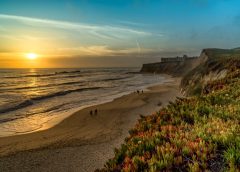
As pandemic restrictions lift and travel resurges, San Mateo County is getting a rebrand
[ad_1]
A local organization wants to capitalize on a growing leisure market along the Peninsula
Just two weeks before the first known case of COVID-19 was detected in the Bay Area in January 2020, a group of visionaries gathered for a retreat.
Board members of a local nonprofit, then known as the San Mateo County Silicon Valley Convention and Visitors Bureau, the attendees brainstormed ideas for reinvigorating the Peninsula. The major issue, as they saw it, was branding.
Now, more than 50 years after launching, the organization has been officially re-christened “The San Francisco Peninsula”—the region’s go-to source for visitors, convention-goers and curious locals. The makeover, President and CEO John Hutar hopes, will bring renewed attention to a sometimes-overlooked region of the Bay. Their new slogan captures that sentiment: “South of San Francisco, North of Expectations.”
“We needed to differentiate ourselves somehow,” Hutar said. “It was time to reboot the organization.”
As of 2020, San Mateo County was home to 764,442 residents spanning 20 cities and towns from Daly City to Half Moon Bay. The county manages more than 20 parks, trails and historic sites, as well as 30 miles of bay-front and nearly 60 miles of ocean-front coastline.
During the pre-pandemic retreat, members discussed survey responses and data from focus groups and interviews with local stakeholders, travelers and residents. They arrived at several key takeaways: Their existing title was too long, too vague and lacked name recognition. There was an untapped opportunity to leverage San Francisco’s international cachet to their advantage.
“San Francisco is a great place, a world famous place, a destination,” said Jon Miller, longtime San Mateo County resident and announcer for the San Francisco Giants. “Lesser known is just a few miles down the road.”
Then, almost two months to the day after the retreat, the first shelter-in-place orders shut down the Bay Area, completely changing the game for The San Francisco Peninsula.
Suddenly, enjoyment of many of the region’s attractions—wineries, Michelin star restaurants, renowned venues—was put on hold, while in their place, new opportunities arose.
“Our profound footprint of open spaces was very much sought after during the COVID crisis,” Hutar said. And with a new, more recognizable name, he hoped that the Peninsula would catch the eye of visitors seeking refuge in Northern California’s natural beauty.
Previously, local tourism relied primarily on conventions and corporate travel. In the last year, however, leisure tourism has been “carrying the water,” according to Hutar, who expects the trend to continue. For the first time in two years, local hotel occupancy is approaching pre- pandemic levels.
“In the near term, with continued economic issues of inflation and high gas prices, we are well-positioned to continue growing the leisure market,” he said.
There were, however, some growing pains, Hutar admitted. The effects were mostly felt along the coast, where retail is sparse, and beach-goers flooded the highways and public parks, leaving behind trash.
“I had one mayor call me and say, ‘hey can you slow this marketing down?’” Hutar said. “So we helped with that.”
From an economic perspective, Hutar hopes to see a reopening of corporate campuses and, with it, a resurgence of business travel. He said he was “optimistic” about the amount of construction happening, particularly in biotech; currently, at least five projects are in the works from South San Francisco to Redwood City.
Addressing some residents’ concerns about increased traffic, Hutar said he thought the footprint of new developments would be “minimal.”
“I think the construction that’s happening now is smart and will help boost the economy,” he said.
While The San Francisco Peninsula is wholly dedicated to attracting, informing and guiding visitors to the area, Hutar praised the regional chambers of commerce for their recent efforts to promote shopping locally. He noted that the widespread adoption of outdoor dining, despite its challenges, has also helped reinvigorate the local economy. He was particularly buoyed by the success of this year’s restaurant week.
“If we were to fast forward 5-10 years, I would really see [our dining] competing on a regional level,” he said.
In a presentation, Miller, the longtime sports announcer, shared his own appreciation for what the county had to offer.
“The San Francisco Peninsula is a place that is just as remarkable [as San Francisco] with views that are just as iconic, without the crowds and without having to fight all the traffic,” he said. “For me that is the great reason to…get out of the city and head down and explore the real treats that are there.”
[ad_2]
Source link


